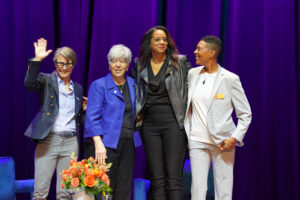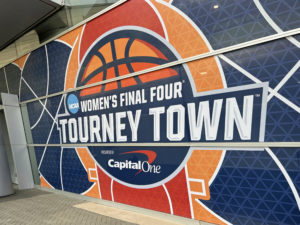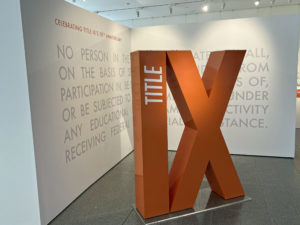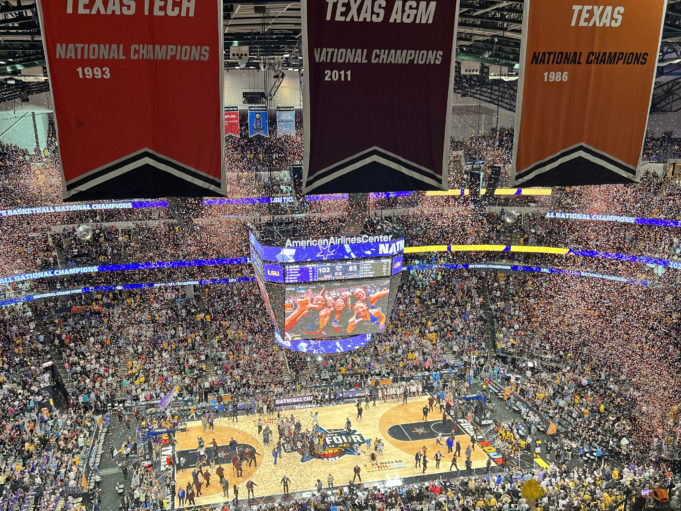The NCAA Women’s Final Four put history on display this weekend in North Texas.
As Dallas Sports Commission Executive Director Monica Paul explained during the AT&T Beyond The Baseline panel she emceed Thursday, 2023 marked the first Women’s Final Four since the 50th anniversary of the groundbreaking Title IX legislation. The law created sports opportunities for many young women. It also helped spur the NCAA to begin sanctioning women’s sports in 1982.
Watching Iowa’s Caitlin Clark and LSU’s Jasmine Carson drain deep three-pointers in the final game this year made for compelling drama. The vibe was a much different one than in 1982, and not just because they didn’t play with a three-point line at that point in the game’s development.
“It’s just been a pleasure to see the growth from my days back in the early ‘80s to now,” said Fort Worth ISD Athletic Director Lisa Langston began her collegiate basketball career at Texas A&M the season after the NCAA bought into women’s athletics. “It’s as different as day and night and that’s a fantastic thing.”
2023 also marked the eighth time Texas has hosted the Women’s Final Four, more than any other state. According to longtime University of Texas at Austin Executive Senior Associate Athletics Director Chris Plonsky, the state has set an example for the sport’s development. She credits in large part the work of Donna Lopiano, whose pending Women’s Basketball Hall of Fame induction was recognized at a Friday breakfast both Langston and Plonsky attended.
for the sport’s development. She credits in large part the work of Donna Lopiano, whose pending Women’s Basketball Hall of Fame induction was recognized at a Friday breakfast both Langston and Plonsky attended.
“She was among the benchmark college administrators because she had a title, an empowered title, of women’s athletics director to sort of embed on a major research campus and fight the good fight, everything from ‘I need a gym, I need courts, I need fields,’” said Plonsky of Lopiano, who had become UT’s director of women’s athletics in 1975 and stayed for 18 years.
Langston sees the results of the efforts of Lopiano and other trailblazers when she returns to her alma mater.
“I would think the biggest sign of progress is the facilities,” said Langston.
The NCAA played its first two finals in the Scope, an arena in Norfolk, Virginia with a capacity of nearly 11,000 spectators. They filled it to about three quarters of capacity. Their predecessor organization, the women-only AIAW, held its last tournament in 1982, drawing less than 2,000 fans to Philadelphia’s Palestra on the Penn campus for its final.
Today, the women’s tournament has a lot more venue options – and a lot higher attendance. Dallas sold out its NBA arena, the American Airlines Center. The NCAA has also utilized even larger spaces, including football stadia. The improvement in physical resources runs deeper than just where they play the games, according to Langston.
“The workout facilities that the female student athletes have, when I go back down to A&M, and I look at what they have to improve their games,” she noted. “It’s just overall improvement in amenities and services to student athletes.”
However, a common theme at many of the week’s panels revolved around the idea that significant obstacles must still be overcome for female athletes to enjoy benefits from sports equal to those of their male counterparts. Ironically, the last time the state of Texas hosted a Women’s Final Four, revelations of substandard workout facilities in comparison with those at the men’s tournament brought the NCAA’s commitment to gender equity into serious question.
2021’s imbroglio in San Antonio likely didn’t shock Lopiano. Speaking to her at the breakfast, she suggested many athletic powers-that-be don’t have a “genuine commitment to gender equity.”
Her Longhorns hosted the 1987 Women’s Final Four in Austin, selling the event out for the first time. The 2002 Women’s Final Four in the Alamodome set attendance records for the event. But she’d actually prefer the NCAA didn’t award the state future such competitions, at least in the short term.
“The political climate in Texas is not favorable to women,” Lopiano suggested.
She believes governing bodies shouldn’t award marquee events to such states, similarly to how Major League Baseball pulled its 2021 All-Star Game out of Atlanta in response to changes in Georgia voting laws. Regardless of how one feels about Texas’s governing bodies handle reproductive rights, opportunities for businesswomen, and other crucial political issues, one can understand Lopiano’s proposed remedy.
“You have to have enough women in positions of power to get the conference to do the right thing, to get the NCAA to do the right thing,” she said.
Other entities outside administration also have the ability to create change. One vital category includes those who can direct investment toward women’s sports.
“As we look at how many corporate dollars go to women’s sports, the number is growing,” WNBA Commissioner Cathy Engelbert suggested at a Friday panel.
 As one walked around the Dallas Convention Center’s Tourney Town (presented by Capital One), one could engage with extensive sampling booths, entertainment options, and photo ops courtesy of NCAA corporate partners. Sponsor activation around the women’s tournament has traditionally lagged substantially behind the men’s version. The question now is whether commitments such as the ones we saw this year will remain in place and grow. That hasn’t previously been the case, Lopiano said.
As one walked around the Dallas Convention Center’s Tourney Town (presented by Capital One), one could engage with extensive sampling booths, entertainment options, and photo ops courtesy of NCAA corporate partners. Sponsor activation around the women’s tournament has traditionally lagged substantially behind the men’s version. The question now is whether commitments such as the ones we saw this year will remain in place and grow. That hasn’t previously been the case, Lopiano said.
“I think it provokes a level of guilt that makes people do great things, momentarily, via sponsorships or events or you or you take advantage of the economic value of something because of the occasion. And you while you appreciate it, you also see it for what it is. And you’re looking for long term genuine commitment. And that hasn’t been around.”
The ability to reach an audience will always appeal to potential sponsors. Women’s sports have started to receive more media coverage, and viewership gains have followed. But perhaps the most crucial element to generating the staying power necessary to grow the investment is data, and recent numbers have begun to show how valuable a women’s sports audience can be in terms of purchasing power and affinity. One would expect media planners and sponsorship agencies to, if they’re doing their jobs right, look at the numbers.
And perhaps the more the higher levels of women’s sport grow, the more help it will be for women like Langston as they look to generate more girls’ participation in athletics.
“I think it’s just exposure,” she said. As the women get televised more, kids can see themselves, people that look like them, on TV.”
Plonsky suggested that many of the potential beneficiaries in Texas may already have advantages thanks to Lopiano’s work in the university setting serving as the “fulcrum” for driving improvements in the high schools and below.
Lopiano also noted Texas’s grassroots success, as well as its rich collegiate history with Wayland Baptist, UT, Texas Tech and more (including Langston’s Aggies, who won a national title in 2011).
 A Texas company, AT&T, devoted a section of the lobby of their Dallas headquarters to celebrate Title IX in March. Will that sort of effort help drive home the idea that athletics can be a huge benefit for women, at whatever level, contrary to what many believed when it passed?
A Texas company, AT&T, devoted a section of the lobby of their Dallas headquarters to celebrate Title IX in March. Will that sort of effort help drive home the idea that athletics can be a huge benefit for women, at whatever level, contrary to what many believed when it passed?
“That’s history. You have to go forward,” observed Lopiano. “You just have to rattle the cages going forward.”
Sometimes learning from the lessons of the past can help one go forward – and do some cage-rattling – and perhaps make more history.













